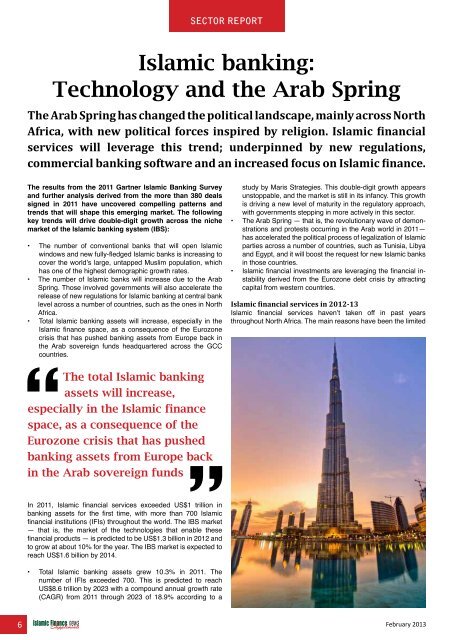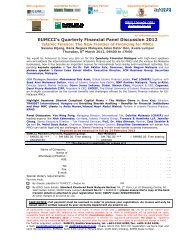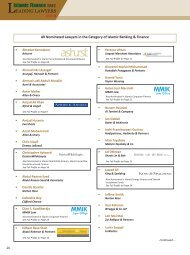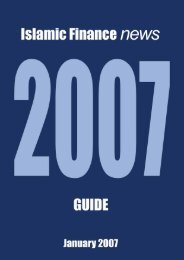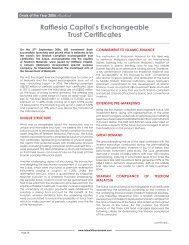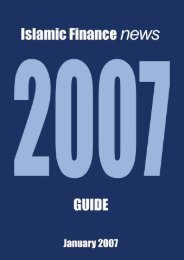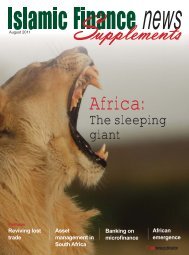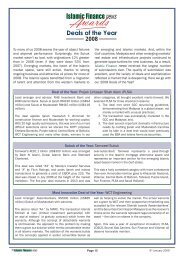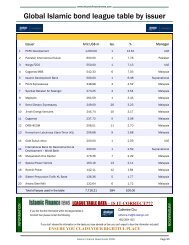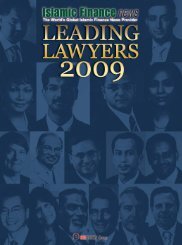View PDF Edition - Islamic Finance News
View PDF Edition - Islamic Finance News
View PDF Edition - Islamic Finance News
Create successful ePaper yourself
Turn your PDF publications into a flip-book with our unique Google optimized e-Paper software.
sector report<br />
<strong>Islamic</strong> banking:<br />
Technology and the Arab Spring<br />
The Arab Spring has changed the political landscape, mainly across North<br />
Africa, with new political forces inspired by religion. <strong>Islamic</strong> financial<br />
services will leverage this trend; underpinned by new regulations,<br />
commercial banking software and an increased focus on <strong>Islamic</strong> finance.<br />
The results from the 2011 Gartner <strong>Islamic</strong> Banking Survey<br />
and further analysis derived from the more than 380 deals<br />
signed in 2011 have uncovered compelling patterns and<br />
trends that will shape this emerging market. The following<br />
key trends will drive double-digit growth across the niche<br />
market of the <strong>Islamic</strong> banking system (IBS):<br />
• The number of conventional banks that will open <strong>Islamic</strong><br />
windows and new fully-fledged <strong>Islamic</strong> banks is increasing to<br />
cover the world’s large, untapped Muslim population, which<br />
has one of the highest demographic growth rates.<br />
• The number of <strong>Islamic</strong> banks will increase due to the Arab<br />
Spring. Those involved governments will also accelerate the<br />
release of new regulations for <strong>Islamic</strong> banking at central bank<br />
level across a number of countries, such as the ones in North<br />
Africa.<br />
• Total <strong>Islamic</strong> banking assets will increase, especially in the<br />
<strong>Islamic</strong> finance space, as a consequence of the Eurozone<br />
crisis that has pushed banking assets from Europe back in<br />
the Arab sovereign funds headquartered across the GCC<br />
countries.<br />
study by Maris Strategies. This double-digit growth appears<br />
unstoppable, and the market is still in its infancy. This growth<br />
is driving a new level of maturity in the regulatory approach,<br />
with governments stepping in more actively in this sector.<br />
• The Arab Spring — that is, the revolutionary wave of demonstrations<br />
and protests occurring in the Arab world in 2011—<br />
has accelerated the political process of legalization of <strong>Islamic</strong><br />
parties across a number of countries, such as Tunisia, Libya<br />
and Egypt, and it will boost the request for new <strong>Islamic</strong> banks<br />
in those countries.<br />
• <strong>Islamic</strong> financial investments are leveraging the financial instability<br />
derived from the Eurozone debt crisis by attracting<br />
capital from western countries.<br />
<strong>Islamic</strong> financial services in 2012-13<br />
<strong>Islamic</strong> financial services haven’t taken off in past years<br />
throughout North Africa. The main reasons have been the limited<br />
The total <strong>Islamic</strong> banking<br />
assets will increase,<br />
especially in the <strong>Islamic</strong> finance<br />
space, as a consequence of the<br />
Eurozone crisis that has pushed<br />
banking assets from Europe back<br />
in the Arab sovereign funds<br />
In 2011, <strong>Islamic</strong> financial services exceeded US$1 trillion in<br />
banking assets for the first time, with more than 700 <strong>Islamic</strong><br />
financial institutions (IFIs) throughout the world. The IBS market<br />
— that is, the market of the technologies that enable these<br />
financial products — is predicted to be US$1.3 billion in 2012 and<br />
to grow at about 10% for the year. The IBS market is expected to<br />
reach US$1.6 billion by 2014.<br />
• Total <strong>Islamic</strong> banking assets grew 10.3% in 2011. The<br />
number of IFIs exceeded 700. This is predicted to reach<br />
US$8.6 trillion by 2023 with a compound annual growth rate<br />
(CAGR) from 2011 through 2023 of 18.9% according to a<br />
6 February 2013


